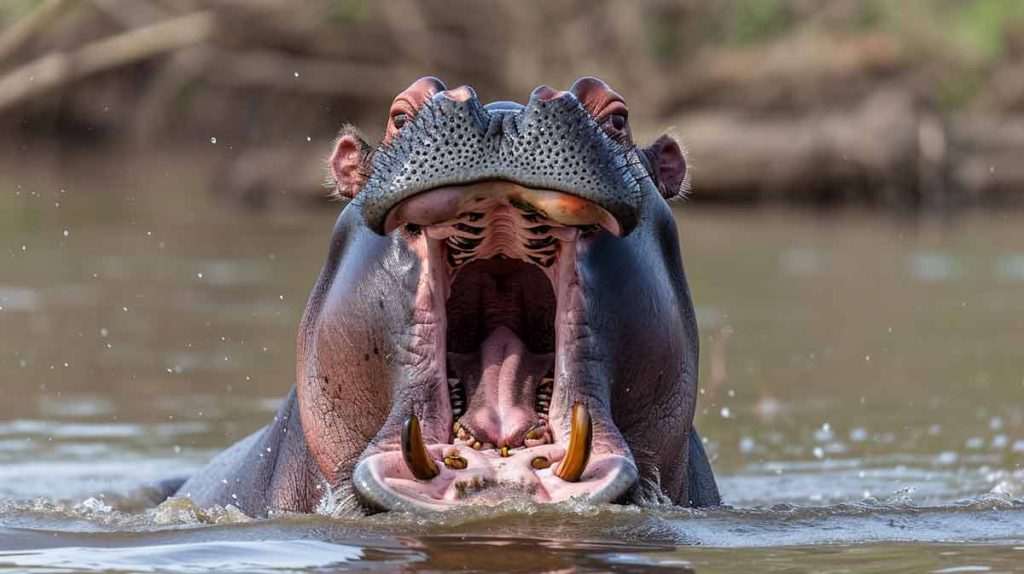Did you know that hippos are not solitary animals but live in groups called herds or pods? These massive creatures, known for their size and strength, exhibit fascinating group behaviour essential for survival in the wild.
Key Takeaways:
- Hippos live in groups, known as herds or pods, rather than solitary lives.
- Group living is crucial for the survival and well-being of hippos.
- Hippos exhibit complex social structures within their groups.
- Group interactions and behaviours play a significant role in the lives of hippos.
- In groups, hippos can share resources and knowledge and protect their young.
The Complex Social Structure of Hippos
Hippos live in groups called pods or herds, typically led by a dominant male bull. Their social structure is complex, with each individual having a hierarchy within the group. They are highly social animals and use various forms of communication, including vocalizations and body language, to interact with one another. Various interactions and relationships within the pod contribute to the group’s overall dynamics.
During their interactions, hippos display fascinating social behaviours that shape their group dynamics. They establish hierarchies based on size and strength, with the dominant male leading the group. The dominant male has access to the best feeding and breeding opportunities and is crucial in maintaining order and resolving conflicts within the pod. Conversely, subordinates must navigate the social landscape and consider their position in the hierarchy when interacting with other individuals.
But it’s not just the males that contribute to the social structure of hippos. Female hippos also play a vital role in the group dynamics. They form strong bonds with other females and share maternal responsibilities, such as caring for and protecting the young calves. This cooperative behaviour ensures the survival and well-being of the entire pod.
Hippo Social Structure
The social structure of hippos can be visualized as a hierarchical pyramid, with the dominant male bull at the top. Below the dominant male are the subordinate males, followed by the adult females and, finally, the young calves. Each individual knows his or her place in the hierarchy and acknowledges the authority of those above him or her.
Within the social structure, hippos also exhibit territorial behaviour. They mark their territory with their dung and engage in aggressive displays to defend their space from intruders. These territorial boundaries are essential for maintaining order within the group and preventing conflicts between neighbouring pods.

The intricate social behaviour of hippos highlights their strong bond as a group and the importance of social cohesion for their survival. By living and interacting in a structured social environment, hippos thrive in their natural habitat and adapt to changing circumstances more effectively.
The social behavior of hippos is a fascinating display of cooperation, dominance, and communication. Their complex social structure and group dynamics contribute to the overall success and resilience of the pod. Understanding these behaviors provides valuable insights into the lives of these magnificent creatures.
| Key Aspects | Details |
|---|---|
| Social Structure | Hierarchical, led by a dominant male bull |
| Communication | Vocalizations and body language |
| Interactions | Intricate dynamics within the pod |
| Cooperative Behavior | Strong bonds among females, communal care for calves |
| Territoriality | Marking territory, defending against intruders |
Group Interactions and Behaviors
Hippos engage in various group interactions and behaviours, contributing to their collective well-being and survival. These interactions showcase the complex social dynamics of these magnificent creatures.
One notable behaviour among hippos is their courtship rituals. Males compete for the attention of females through displays of strength and dominance. These displays often involve vocalizations, posturing, and even physical confrontations. The competitive nature of courtship reflects the importance of finding a suitable mate within the group.
Furthermore, hippos have adapted to mate in water. The buoyancy offered by the water allows for easier mating, especially considering their large size and weight. This aquatic courtship adds a fascinating dimension to their group interactions and reinforces the significance of water within their social structure.
Another remarkable behaviour exhibited by hippos is their unwavering commitment to protecting their young. Adult male and female hippos fiercely defend their calves against any potential threats. This parental instinct highlights the strong bonds within the group and underscores the collective responsibility for the safety and well-being of the herd’s offspring.
Additionally, hippos demonstrate communal care for their young. It is not uncommon to witness multiple adults, including males and females, actively participating in raising and caring for the calves. This collective effort contributes to the survival and development of the younger members of the herd, fostering a sense of shared responsibility and cooperation.
These group behaviours among hippos are vital for ensuring the herd’s success. By engaging in courtship rituals, protecting their young, and participating in communal care, hippos establish and maintain strong social bonds within the group. These interactions contribute to the overall cohesion and resilience of the herd, allowing them to navigate their environment more effectively and adapt to changing circumstances.
Overall, hippos’ group interactions and collective behaviours highlight the intricate social structure within their herds. From courtship rituals to protective instincts and communal care, hippos demonstrate the importance of cooperation and shared responsibility for the well-being and survival of the group.
The Importance of Group Living for Hippos

Living in groups is crucial for hippos’ survival. These majestic creatures, known for their formidable size and strength, thrive in groups called herds. Hippos living in groups provide protection and support for individual members, allowing them to navigate their environment more effectively.
Collaboration is key within a herd of hippos. By working together, these social animals can find ample food and water sources, ensuring the sustenance of all group members. They also share valuable knowledge and resources, leveraging the collective intelligence of the herd.
Group living serves as a means of survival and fosters social and emotional well-being for hippos. They form strong bonds and relationships within their pod, providing a sense of belonging and security. These connections contribute to the overall health and resilience of the herd.
Ultimately, hippos living in groups exemplify the power of cooperation in the animal kingdom. They adapt to changing environmental conditions and thrive in their natural habitat through their collective efforts. The herd becomes not only a source of protection and resources but also a community that enhances the lives of its members.
FAQ
What is a group of hippos called?
A group of hippos is called a bloat, a herd or a pod.
Are bloat and herd the same thing?
A bloat and a herd differ depending on the described animal groups. A Bloat refers specifically to a group of hippos, while the herd is a general term for various grazing animals like elephants, zebras, and wildebeest.
Why is a group of hippos called a bloat?
“bloat” is a collective noun used to describe a group of hippos. It is derived from the behaviour of hippos congregating in water, where they often appear bloated due to their buoyant bodies and large size.
Do all animals have specific collective names, like hippos?
Many animals have specific collective nouns used to describe groups, such as’ a pride of lions,’ ‘ a swarm of bees,’ or’ a dazzle of zebras.’ Collective nouns have been used since the 15th century and are commonly associated with wildlife and animal behaviour.
Are there any collective nouns used for animals other than mammals?
Yes, collective nouns are used for various animals, including birds, reptiles, and insects. For instance, ‘ a murder of crows,’ ‘ a bask of crocodiles,’ and’ a confusion of guinea fowl’ are collective nouns used for different animal groups.
What are some examples of collective nouns used for other animals?
Other examples of collective nouns used for animals include’ a colony of ants,’ ‘ a parliament of owls,’ ‘ a conspiracy of ravens,’ and’ a swarm of bees.’ These terms represent the behaviour or characteristic traits of specific animal groups.
Is the term “bloat” only used for hippos in Africa?
While hippos are typically associated with African wildlife, “bloat” can describe a group of hippos regardless of location. However, it is most commonly used in the context of hippos in Africa.
Are there other animals in Africa with unique collective names?
Are there other animals in Africa with unique collective names?
Yes, in addition to hippos, several African animals have unique collective names. For example, ‘ a leap of leopards,’ ‘ a tower of giraffes,’ and’ a crash of rhinoceroses’ are collective nouns used to describe groups of specific African wildlife.
